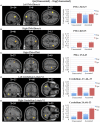Speech motor brain regions are differentially recruited during perception of native and foreign-accented phonemes for first and second language listeners
- PMID: 25232302
- PMCID: PMC4153045
- DOI: 10.3389/fnins.2014.00275
Speech motor brain regions are differentially recruited during perception of native and foreign-accented phonemes for first and second language listeners
Abstract
Brain imaging studies indicate that speech motor areas are recruited for auditory speech perception, especially when intelligibility is low due to environmental noise or when speech is accented. The purpose of the present study was to determine the relative contribution of brain regions to the processing of speech containing phonetic categories from one's own language, speech with accented samples of one's native phonetic categories, and speech with unfamiliar phonetic categories. To that end, native English and Japanese speakers identified the speech sounds /r/ and /l/ that were produced by native English speakers (unaccented) and Japanese speakers (foreign-accented) while functional magnetic resonance imaging measured their brain activity. For native English speakers, the Japanese accented speech was more difficult to categorize than the unaccented English speech. In contrast, Japanese speakers have difficulty distinguishing between /r/ and /l/, so both the Japanese accented and English unaccented speech were difficult to categorize. Brain regions involved with listening to foreign-accented productions of a first language included primarily the right cerebellum, left ventral inferior premotor cortex PMvi, and Broca's area. Brain regions most involved with listening to a second-language phonetic contrast (foreign-accented and unaccented productions) also included the left PMvi and the right cerebellum. Additionally, increased activity was observed in the right PMvi, the left and right ventral superior premotor cortex PMvs, and the left cerebellum. These results support a role for speech motor regions during the perception of foreign-accented native speech and for perception of difficult second-language phonetic contrasts.
Keywords: Broca's area; accent; cerebellum; fMRI; internal model; non-native speech; premotor; speech perception.
Figures







Similar articles
-
Effects of Listener Age and Native Language Experience on Recognition of Accented and Unaccented English Words.J Speech Lang Hear Res. 2019 Apr 26;62(4S):1131-1143. doi: 10.1044/2018_JSLHR-H-ASCC7-18-0122. J Speech Lang Hear Res. 2019. PMID: 31026190 Free PMC article.
-
Phonetic perceptual identification by native- and second-language speakers differentially activates brain regions involved with acoustic phonetic processing and those involved with articulatory-auditory/orosensory internal models.Neuroimage. 2004 Jul;22(3):1182-94. doi: 10.1016/j.neuroimage.2004.03.006. Neuroimage. 2004. PMID: 15219590
-
Effects of listener age and native language on perception of accented and unaccented sentences.J Acoust Soc Am. 2018 Dec;144(6):3191. doi: 10.1121/1.5081711. J Acoust Soc Am. 2018. PMID: 30599683 Free PMC article.
-
Neural bases of accented speech perception.Front Hum Neurosci. 2015 Oct 6;9:558. doi: 10.3389/fnhum.2015.00558. eCollection 2015. Front Hum Neurosci. 2015. PMID: 26500526 Free PMC article. Review.
-
Emergence of category-level sensitivities in non-native speech sound learning.Front Neurosci. 2014 Aug 8;8:238. doi: 10.3389/fnins.2014.00238. eCollection 2014. Front Neurosci. 2014. PMID: 25152708 Free PMC article. Review.
Cited by
-
Language Brain Representation in Bilinguals With Different Age of Appropriation and Proficiency of the Second Language: A Meta-Analysis of Functional Imaging Studies.Front Hum Neurosci. 2019 May 21;13:154. doi: 10.3389/fnhum.2019.00154. eCollection 2019. Front Hum Neurosci. 2019. PMID: 31178707 Free PMC article.
-
Loss of regional accent after damage to the speech production network.Front Hum Neurosci. 2015 Nov 5;9:610. doi: 10.3389/fnhum.2015.00610. eCollection 2015. Front Hum Neurosci. 2015. PMID: 26594161 Free PMC article.
-
First Language Attrition: What It Is, What It Isn't, and What It Can Be.Front Hum Neurosci. 2021 Sep 7;15:686388. doi: 10.3389/fnhum.2021.686388. eCollection 2021. Front Hum Neurosci. 2021. PMID: 34557079 Free PMC article. Review.
-
Reanalyzing neurocognitive data on the role of the motor system in speech perception within COSMO, a Bayesian perceptuo-motor model of speech communication.Brain Lang. 2018 Dec;187:19-32. doi: 10.1016/j.bandl.2017.12.003. Epub 2017 Dec 12. Brain Lang. 2018. PMID: 29241588 Free PMC article.
-
Sublexical cues affect degraded speech processing: insights from fMRI.Cereb Cortex Commun. 2022 Feb 16;3(1):tgac007. doi: 10.1093/texcom/tgac007. eCollection 2022. Cereb Cortex Commun. 2022. PMID: 35281216 Free PMC article.
References
-
- Akahane-Yamada R. (1996). Learning non-native speech contrasts: what laboratory training studies tell us, in Proceedings of Acoustical Society of America and Acoustical Society of Japan Third Joint Meeting (Honolulu, HI: ), 953–958
LinkOut - more resources
Full Text Sources
Other Literature Sources

